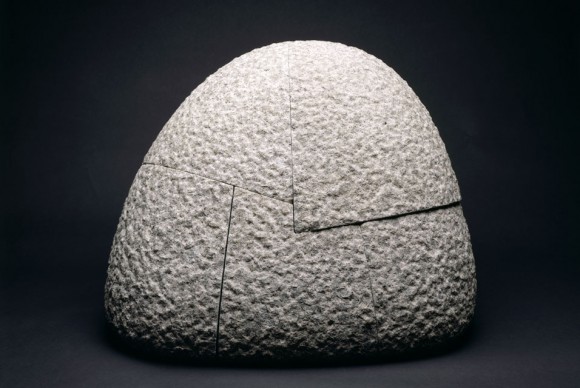Portland Japanese Garden exhibits works by acclaimed artist Isamu Noguchi
May 5, 2013 by All Art News
Filed under Sculpture
PORTLAND, ORE.- The Portland Japanese Garden presents the exhibition Isamu Noguchi: We Are the Landscape of All We Know, from May 3–July 21, 2013. The exhibition, organized in collaboration with The Isamu Noguchi Foundation and Garden Museum in Long Island City, New York, features 22 works by acclaimed sculptor Isamu Noguchi amid the setting of the most authentic Japanese garden in North America.
“Although Isamu Noguchi is primarily known as a sculptor, it’s safe to say his career was a response to what he saw as a reductive view toward sculpture. His choice in materials spoke to both nature and the urban environment, and his approach seamlessly integrated his work in other areas like ceramics, theater sets and industrial design, and what he termed sculptural spaces, including gardens and playgrounds,” says Matt Kirsch, Associate Curator of The Noguchi Museum. “His work reflects so much from the Eastern, European and American cultures he encountered, and like so many artists, he merged their commonalities into a singular and personal vision.”
The first retrospective of Noguchi’s work was held in 1968 at the Whitney Museum of American Art. Today, his work is represented in more than 50 public collections in the United States.

Young Mountain. Photo courtesy of The Isamu Noguchi Foundation and Garden Museum, New York. 1970. Aji granite, 13 3/8 x 17 5/8 x 13 1/4 in. Sculpture: 126 lbs.
The works in the Japanese Garden’s exhibition date from the late 1940s to the mid 1980s, spanning the artist’s long career in sculpture and design. Stone and metal sculptures will be exhibited inside the Garden’s Pavilion Gallery along with ink drawings on paper and Akari paper lanterns. Four large-scale stone sculptures will be installed outdoors, surrounded by the traditional Japanese garden styles that were among the global influences on Noguchi’s work.
Noguchi prized the beauty and vitality of natural materials such as stone and wood, and his abstract, modern designs incorporate many elements of traditional Japanese arts, such as simplicity, craftsmanship, and attention to detail. Noguchi’s work, at once subtle and bold, traditional and modern, is seen as a true bridge between East and West.
Isamu Noguchi (1904–1988) was one of the twentieth century’s most critically acclaimed sculptors. Through a lifetime of artistic experimentation, Noguchi created not only sculpture but also gardens, furniture and lighting designs, ceramics, and architecture. His set designs for Martha Graham, Merce Cunningham, and George Balanchine earned him a reputation as an artist capable of working across disciplines. The designs he created in the 1940s for Herman Miller—most notably his free-form coffee table—have become modern icons, as have his Akari paper lanterns.
This exhibition is presented by Arlene Schnitzer/The Harold and Arlene Schnitzer CARE Foundation with additional support provided by the Oregon Cultural Trust, the Autzen Foundation, and Desgin Within Reach.
Isamu Noguchi: We Are the Landscape of All We Know (May 3–July 21, 2013) is open during the Portland Japanese Garden’s Spring/Summer Season hours (Noon–7 p.m. Monday and 9 a.m.-7 p.m. Tuesday–Sunday with the exception of Saturdays when the Garden will stay open until 9:00 p.m. for the duration of the exhibition). Entrance is included with Garden admission ($9.50 Adult; $7.75 Senior [62+]; $7.75 College Student [w/ID]; $6.75 Youth [6-17]). The Portland Japanese Garden is located at 611 SW Kingston Ave. in Portland, Ore. For more on the Portland Japanese Garden, its exhibitions, and its programs, please call (503) 223-1321 or visit japanesegarden.com.
Born in 1904 in Los Angeles to an American mother and a Japanese father, Isamu Noguchi lived in Japan until the age of 13. He returned to the United States to live and study, finally moving to New York, where he was greatly influenced by an exhibition of works by Constantin Brancusi. Noguchi traveled to Paris on a Guggenheim fellowship in 1924 to work in Brancusi’s studio. Returning to New York in 1929, Noguchi made a living during the depression as a portrait sculptor, earning money to fund other projects, including his travel expenses to work on a mural commission with the painter Diego Rivera on a mural in Mexico City. His first large commission in the United States was a sculpture depicting the freedom of the press for the entrance of the Associated Press Building in New York City, completed in 1940.
After World War II, Noguchi’s work expanded to include gardens, fountains, and the large-scale public sculptures for which he is widely known. He continued to work in New York City, and established a second studio in 1969 in the village of Mure on the island of Shikoku in Japan, which is now open to the public as Noguchi Garden Museum, Japan. Toward the end of a long internationally acclaimed career, Noguchi opened The Isamu Noguchi Garden Museum (now known as The Noguchi Museum), in Long Island City, Queens, New York in 1985. The museum, established and designed by the artist, marked the culmination of his commitment to public spaces.
In 1986, Noguchi represented the United States at the Venice Biennale. He received the Edward MacDowell Medal for Outstanding Lifetime Contribution to the Arts in 1982; the Kyoto Prize in Arts in 1986; the National Medal of Arts in 1987; and the Order of Sacred Treasure from the Japanese government in 1988. He died in New York City in 1988.
